Scenario mapping for Dummies
Download as pptx, pdf26 likes11,298 views
This document discusses scenario mapping, a technique used in design and research. Scenario mapping involves gathering a project team, identifying key user goals or tasks, and then mapping out scenarios on post-it notes in a large space to understand user needs and envision possible designs. Scenario mapping provides benefits as both a research tool to understand user needs and an early design tool to ideate solutions before building prototypes.
1 of 18
Downloaded 105 times
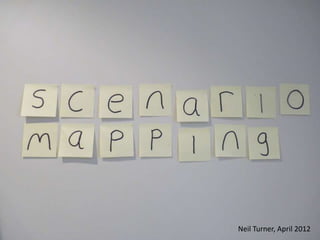
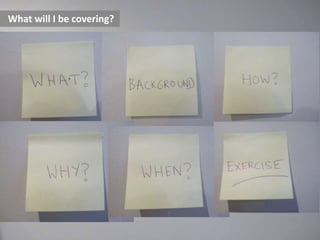
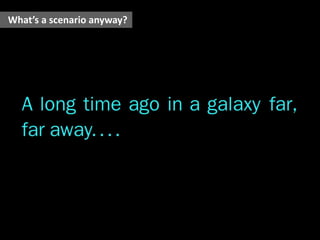
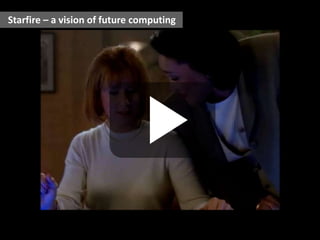

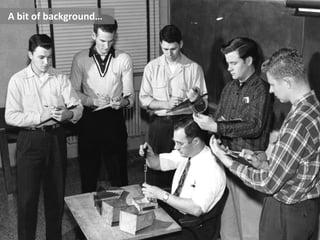
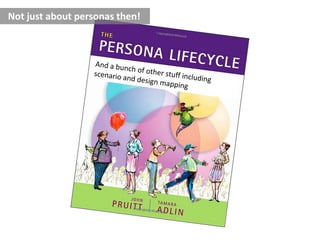
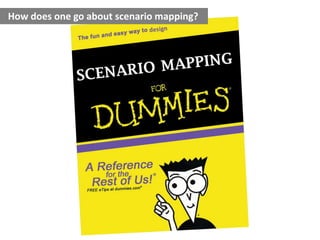
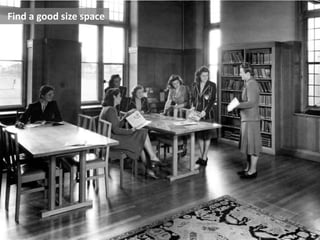
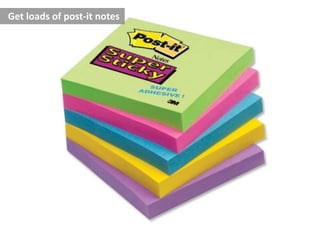

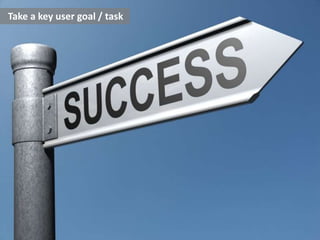
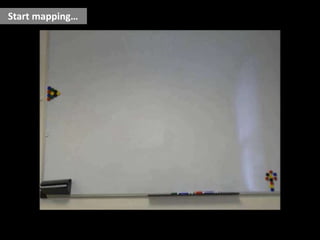
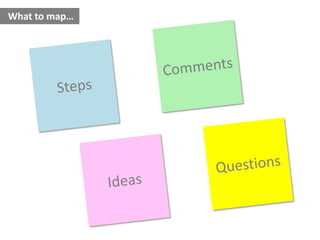
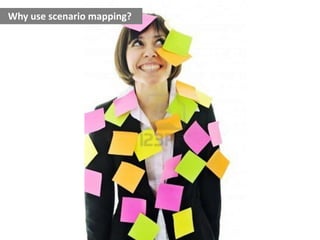
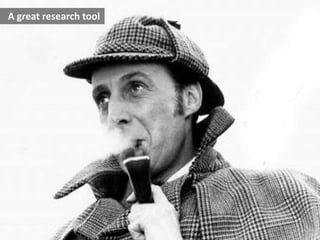
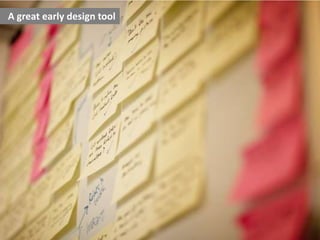
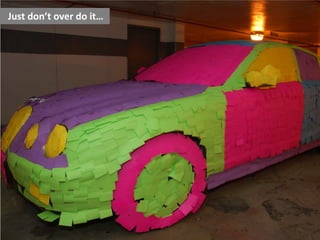
Ad
Recommended
Scenario Mapping Introduction
Scenario Mapping Introductionbobweber
?
Scenario mapping is an interactive planning process used to address complex issues by creating plausible future scenarios and exploring alternative outcomes. It empowers participants to better understand diverse perspectives and uncertainties, enabling informed strategic decision-making. This approach helps organizations anticipate future challenges and develop actionable strategies.Remote design sprints - Lessons from a brave new remote world.pptx
Remote design sprints - Lessons from a brave new remote world.pptxNeil Turner
?
The document discusses remote design sprints, emphasizing their effectiveness despite skepticism surrounding the lack of in-person interaction. It provides ten essential tips for conducting successful remote design sprints, such as keeping participant numbers small, scheduling over two weeks, mixing synchronous and asynchronous activities, and utilizing remote collaboration tools. Notable insights from experts like Jake Knapp highlight that remote design sprints have been conducted successfully numerous times.Continuous discovery – holy grail, or poisoned chalice?
Continuous discovery – holy grail, or poisoned chalice?Neil Turner
?
Continuous discovery is an ongoing user research approach used by agile teams involving weekly customer interactions to inform product development decisions. While beneficial, it presents pitfalls such as ill-judged targets, narrow research, and jumping to conclusions. The goal is to enhance product outcomes through quality interactions and structured research activities.Continuous discovery – Holy grail, or poisoned chalice (UX Scotland)
Continuous discovery – Holy grail, or poisoned chalice (UX Scotland)Neil Turner
?
This document discusses continuous discovery, an agile product development approach where user research is conducted frequently through small activities to continuously inform decisions. It defines continuous discovery as regular customer touchpoints minimum weekly, conducted by the product team through small research activities pursuing a desired outcome. The document also outlines some potential pitfalls of continuous discovery, such as chasing targets over quality, poorly run research sessions, recruiting unsuitable users, arduous administration tasks, and misleading insights. It emphasizes the importance of alignment with goals, quality over quantity of research, and understanding customer feedback is meant to pursue specific outcomes.Remote design sprints - Lessons from a brave new remote world (Agile Manchest...
Remote design sprints - Lessons from a brave new remote world (Agile Manchest...Neil Turner
?
This document discusses the concept and execution of remote design sprints, which are structured processes to innovate and reduce risks in product development. It contrasts remote sprints with in-person ones and provides ten practical tips for conducting successful remote design sprints, such as keeping the group size small and using a mix of synchronous and asynchronous activities. The author emphasizes that remote design sprints can be effective when done correctly, citing successful experiences in the field.How to grow your growth mindset superpower
How to grow your growth mindset superpowerNeil Turner
?
The document emphasizes developing a growth mindset as a powerful asset for personal and professional development. Key strategies include stepping outside your comfort zone, utilizing learning plans, seeking feedback, and fostering curiosity. Carol Dweck highlights that a growth mindset cultivates resilience and a positive attitude towards challenges.How to choose the right UCD collaboration style.pptx
How to choose the right UCD collaboration style.pptxNeil Turner
?
The document outlines four collaboration styles in user-centered design (UCD): instruct, pair, coach, and delegate, each tailored to different levels of competence and confidence among team members. It includes guidance on matching collaboration styles to individuals based on their experience and emotional state, along with high-level scenarios for application. Additionally, it offers resources for further reading on situational leadership principles related to UCD.Running remote workhops that don't suck slides
Running remote workhops that don't suck slidesNeil Turner
?
The document provides guidelines for conducting effective remote workshops, highlighting the importance of planning, engagement, and follow-up. It emphasizes the need to keep group sizes small and balance activities, while also suggesting using co-facilitators and maintaining participant energy levels. Finally, it outlines the importance of sharing outcomes and reflecting on the workshop for future improvement.Dealing with design debt (UCD Gathering)
Dealing with design debt (UCD Gathering)Neil Turner
?
The document discusses strategies for managing design debt in agile software development, highlighting the importance of consistency, usability, and a clear design system. Key recommendations include validating high-level designs, maintaining records of design debt, and prioritizing user tasks. It emphasizes that addressing design debt requires a collective effort from the entire team.Designer collaboration (from Cambridge Usability Group Unconference 2019)
Designer collaboration (from Cambridge Usability Group Unconference 2019)Neil Turner
?
The document discusses the importance of collaboration among designers and outlines various organizational models (centralized, embedded, hybrid) that can enhance teamwork in design processes. It emphasizes that successful collaboration requires active encouragement through team organization, regular meetings, and the use of supportive tools. Ultimately, the document advocates for ongoing experimentation in collaboration strategies to find what works best in different contexts.UX life hacks - How to work smarter and get more done (UX in the City 2019)
UX life hacks - How to work smarter and get more done (UX in the City 2019)Neil Turner
?
The document discusses UX life hacks, which are methods to enhance productivity and efficiency in user experience design. It includes practical advice on organizing project files, utilizing tools effectively, and engaging in structured workshops. The author encourages sharing personal UX life hacks to foster a collaborative learning environment.Using jobs-to-be-done to design better user experiences (UX Cambridge 2017)
Using jobs-to-be-done to design better user experiences (UX Cambridge 2017)Neil Turner
?
The document discusses the concept of 'jobs-to-be-done' (JTBD) as a critical framework for designing user experiences, emphasizing the distinction between understanding customer needs and merely improving products. It outlines methods for identifying, prioritizing, and mapping these jobs to enhance customer satisfaction and drive innovation. Additionally, it suggests using customer experience maps to visualize the steps customers take to complete their jobs and identify pain points and opportunities for improvement.How to ditch meetings and start playing games (UX in the City - Manchester 2017)
How to ditch meetings and start playing games (UX in the City - Manchester 2017)Neil Turner
?
The document discusses the benefits of design games as an alternative to traditional meetings, highlighting how they can engage participants, foster creativity, and improve productivity. It introduces several design games such as 'Priority Poker' and 'World's Worst,' detailing their objectives, how to play, and when to use them. The author encourages the use of these games to better facilitate collaboration and ideation in design processes.Remote user-testing-101-neil-turner
Remote user-testing-101-neil-turnerNeil Turner
?
A presentation covering moderated and unmoderated remote user testing. The presentation goes through the pros and cons for each technique; some of the remote user testing tools available and some hints and tips for carrying it out.How to design more ethically engaging experiences (UCD 2016)
How to design more ethically engaging experiences (UCD 2016)Neil Turner
?
The document discusses the role of user experience (UX) design, emphasizing the importance of ethical engagement and customer satisfaction. It outlines principles for effective UX, including prioritizing outcomes over user engagement, minimizing notifications, and reducing interface complexity. Additionally, it advocates for responsible technology use, contrasting digital engagement with addictive behaviors fostered by design choices.UCD from across the pond - A case study in remote UX
UCD from across the pond - A case study in remote UXNeil Turner
?
Neil Turner's case study discusses the challenges and strategies of remote user-centered design (UCD) in an increasingly globalized work environment. It highlights the use of various online tools and methods, such as surveys and remote interviews, to effectively conduct UX research and collaborate with teams across different locations and time zones. The document emphasizes the importance of clear communication, structured meeting practices, and planning for successful remote UX work.An introduction to ergonomics for mobile UX (Ux in the City)
An introduction to ergonomics for mobile UX (Ux in the City)Neil Turner
?
The document discusses ergonomics in mobile UX design, highlighting the importance of creating interfaces that fit human physical and cognitive abilities. It presents various rules of thumb for designing comfortable and accessible touch interfaces, such as maximizing tap target sizes, placing common controls within easy reach, and considering diverse user scenarios. Prototyping and user testing are emphasized as crucial steps in developing effective mobile designs.Confessions of a former UCD devotee – How I managed to kick the UCD habit and...
Confessions of a former UCD devotee – How I managed to kick the UCD habit and...Neil Turner
?
User-centered design (UCD) emphasizes meeting the needs of end users at all design stages, with evidence showing that investing in usability can significantly enhance product effectiveness. Lean UCD advocates for a balance between thorough user research and efficiency, suggesting a shift from user-driven to designer-driven approaches. The document highlights techniques and methodologies that streamline the design process while ensuring user considerations remain central.How to ditch meetings and play games instead
How to ditch meetings and play games insteadNeil Turner
?
The document discusses various design games that can replace traditional meetings, highlighting their benefits in promoting creativity and collaboration among players. It provides examples of games such as 'Priority Poker' and 'Snakes & Ladders,' detailing goals, playing methods, and advantages for team engagement. Overall, the emphasis is on using fun, interactive methods to facilitate design processes and enhance team dynamics.The pursuit of tapiness - A case study in making tablet friendly websites
The pursuit of tapiness - A case study in making tablet friendly websitesNeil Turner
?
The document discusses the necessity of creating tablet-friendly websites, particularly for the travel industry, emphasizing the increasing use of tablets for web access. It outlines a process for improving user experience through analytics review, usability testing, and prioritizing design changes while keeping costs manageable. Additionally, it highlights best practices for tablet design and the importance of a long-term strategy for web development that incorporates mobile and tablet considerations.Moving from user centred thinking to system thinking
Moving from user centred thinking to system thinkingNeil Turner
?
Neil Turner discusses the transition from user-centered thinking to system thinking in design, emphasizing the importance of understanding end users' needs throughout the design process. He illustrates how service design and system mapping can enhance user experiences by considering the interplay and relationships between different actors and touchpoints. The document also highlights tools and resources for effective service design.Long distance UX relationships - How to deliver great UX when working with of...
Long distance UX relationships - How to deliver great UX when working with of...Neil Turner
?
The document discusses strategies for delivering effective user experience (UX) when collaborating with offshore development teams. It emphasizes the importance of personal connections, appropriate tools and technology, and the need for detailed planning, such as creating a style guide and prototypes. Additionally, it acknowledges the challenges of remote collaboration and sets expectations for the difficulty of the process.Desire paths lightning talk
Desire paths lightning talkNeil Turner
?
The document discusses 'desire paths,' which are the preferred ways users navigate a website, exemplified by their interactions like searching for holidays or hotels. It outlines various methods to uncover these paths, including analytics, search logs, and user feedback. The aim is to enhance user experience by understanding how users prefer to engage with the site.An introduction to experience maps
An introduction to experience mapsNeil Turner
?
The document introduces experience maps, which are visual representations of customer processes, needs, and perceptions in relation to a company. It discusses the importance of storytelling in understanding customer journeys, using a persona named Helen to illustrate different stages of her experience. The document advises on best practices for creating effective experience maps, emphasizing the need for factual context, stakeholder involvement, and a focus on opportunities rather than just pain points.10 ‘Quite interesting’ things every designer should know about people
10 ‘Quite interesting’ things every designer should know about peopleNeil Turner
?
The document discusses 10 things designers should know about how people process information. It finds that attention spans are short, around 10 minutes; people only remember 20% of information after a month; memories can be inaccurate or changed over time; limited choices can be better than too many; using stories increases understandability and memorability of information; physical products seem more real and valuable than virtual ones; and trust judgments are made within seconds based on visual cues. Overall, the document emphasizes understanding human cognitive biases and limitations to design more effective materials.What is ux design? A behind the scenes tour
What is ux design? A behind the scenes tourNeil Turner
?
The document outlines the process of UX design, emphasizing that design encompasses more than just aesthetics; it's about functionality and user experience. It describes the seven stages of UX design, from initial ideas through sketching and wireframing to the final live page and performance optimization. Key quotes highlight the importance of creating great experiences to foster brand passion among users.Moving from task based to experience based design
Moving from task based to experience based designNeil Turner
?
The document discusses the transition from task-based design to experience-based design, highlighting the importance of creating great customer experiences to foster brand loyalty. It emphasizes the need for user-centric research, mapping customer journeys, and involving stakeholders in the design process to enhance product and service offerings. The document also provides examples of successful experience design, underscores the significance of data in decision-making, and suggests strategies for fostering a design-centered culture within organizations.And what next? A case study in how to get the most out of your user research
And what next? A case study in how to get the most out of your user researchNeil Turner
?
1. Establish a shared understanding of target users through personas and user journeys that illustrate their perspectives and pain points.
2. Use scenarios, storyboards, and narratives to provide details about user experiences at different stages of their journey.
3. Communicate findings creatively through infographics, blogs, roleplaying, and other engaging methods to raise awareness and identify opportunities for improvement.最新版美国威斯康星大学普拉特维尔分校毕业证(鲍奥笔毕业证书)原版定制
最新版美国威斯康星大学普拉特维尔分校毕业证(鲍奥笔毕业证书)原版定制taqyea
?
2025原版威斯康星大学普拉特维尔分校毕业证书pdf电子版【q薇1954292140】美国毕业证办理UWP威斯康星大学普拉特维尔分校毕业证书多少钱?【q薇1954292140】海外各大学Diploma版本,因为疫情学校推迟发放证书、证书原件丢失补办、没有正常毕业未能认证学历面临就业提供解决办法。当遭遇挂科、旷课导致无法修满学分,或者直接被学校退学,最后无法毕业拿不到毕业证。此时的你一定手足无措,因为留学一场,没有获得毕业证以及学历证明肯定是无法给自己和父母一个交代的。
【复刻威斯康星大学普拉特维尔分校成绩单信封,Buy University of Wisconsin-Platteville Transcripts】
购买日韩成绩单、英国大学成绩单、美国大学成绩单、澳洲大学成绩单、加拿大大学成绩单(q微1954292140)新加坡大学成绩单、新西兰大学成绩单、爱尔兰成绩单、西班牙成绩单、德国成绩单。成绩单的意义主要体现在证明学习能力、评估学术背景、展示综合素质、提高录取率,以及是作为留信认证申请材料的一部分。
威斯康星大学普拉特维尔分校成绩单能够体现您的的学习能力,包括威斯康星大学普拉特维尔分校课程成绩、专业能力、研究能力。(q微1954292140)具体来说,成绩报告单通常包含学生的学习技能与习惯、各科成绩以及老师评语等部分,因此,成绩单不仅是学生学术能力的证明,也是评估学生是否适合某个教育项目的重要依据!
我们承诺采用的是学校原版纸张(原版纸质、底色、纹路)我们工厂拥有全套进口原装设备,特殊工艺都是采用不同机器制作,仿真度基本可以达到100%,所有成品以及工艺效果都可提前给客户展示,不满意可以根据客户要求进行调整,直到满意为止!
【主营项目】
一、工作未确定,回国需先给父母、亲戚朋友看下文凭的情况,办理毕业证|办理文凭: 买大学毕业证|买大学文凭【q薇1954292140】威斯康星大学普拉特维尔分校学位证明书如何办理申请?
二、回国进私企、外企、自己做生意的情况,这些单位是不查询毕业证真伪的,而且国内没有渠道去查询国外文凭的真假,也不需要提供真实教育部认证。鉴于此,办理美国成绩单威斯康星大学普拉特维尔分校毕业证【q薇1954292140】国外大学毕业证, 文凭办理, 国外文凭办理, 留信网认证More Related Content
More from Neil Turner (20)
Dealing with design debt (UCD Gathering)
Dealing with design debt (UCD Gathering)Neil Turner
?
The document discusses strategies for managing design debt in agile software development, highlighting the importance of consistency, usability, and a clear design system. Key recommendations include validating high-level designs, maintaining records of design debt, and prioritizing user tasks. It emphasizes that addressing design debt requires a collective effort from the entire team.Designer collaboration (from Cambridge Usability Group Unconference 2019)
Designer collaboration (from Cambridge Usability Group Unconference 2019)Neil Turner
?
The document discusses the importance of collaboration among designers and outlines various organizational models (centralized, embedded, hybrid) that can enhance teamwork in design processes. It emphasizes that successful collaboration requires active encouragement through team organization, regular meetings, and the use of supportive tools. Ultimately, the document advocates for ongoing experimentation in collaboration strategies to find what works best in different contexts.UX life hacks - How to work smarter and get more done (UX in the City 2019)
UX life hacks - How to work smarter and get more done (UX in the City 2019)Neil Turner
?
The document discusses UX life hacks, which are methods to enhance productivity and efficiency in user experience design. It includes practical advice on organizing project files, utilizing tools effectively, and engaging in structured workshops. The author encourages sharing personal UX life hacks to foster a collaborative learning environment.Using jobs-to-be-done to design better user experiences (UX Cambridge 2017)
Using jobs-to-be-done to design better user experiences (UX Cambridge 2017)Neil Turner
?
The document discusses the concept of 'jobs-to-be-done' (JTBD) as a critical framework for designing user experiences, emphasizing the distinction between understanding customer needs and merely improving products. It outlines methods for identifying, prioritizing, and mapping these jobs to enhance customer satisfaction and drive innovation. Additionally, it suggests using customer experience maps to visualize the steps customers take to complete their jobs and identify pain points and opportunities for improvement.How to ditch meetings and start playing games (UX in the City - Manchester 2017)
How to ditch meetings and start playing games (UX in the City - Manchester 2017)Neil Turner
?
The document discusses the benefits of design games as an alternative to traditional meetings, highlighting how they can engage participants, foster creativity, and improve productivity. It introduces several design games such as 'Priority Poker' and 'World's Worst,' detailing their objectives, how to play, and when to use them. The author encourages the use of these games to better facilitate collaboration and ideation in design processes.Remote user-testing-101-neil-turner
Remote user-testing-101-neil-turnerNeil Turner
?
A presentation covering moderated and unmoderated remote user testing. The presentation goes through the pros and cons for each technique; some of the remote user testing tools available and some hints and tips for carrying it out.How to design more ethically engaging experiences (UCD 2016)
How to design more ethically engaging experiences (UCD 2016)Neil Turner
?
The document discusses the role of user experience (UX) design, emphasizing the importance of ethical engagement and customer satisfaction. It outlines principles for effective UX, including prioritizing outcomes over user engagement, minimizing notifications, and reducing interface complexity. Additionally, it advocates for responsible technology use, contrasting digital engagement with addictive behaviors fostered by design choices.UCD from across the pond - A case study in remote UX
UCD from across the pond - A case study in remote UXNeil Turner
?
Neil Turner's case study discusses the challenges and strategies of remote user-centered design (UCD) in an increasingly globalized work environment. It highlights the use of various online tools and methods, such as surveys and remote interviews, to effectively conduct UX research and collaborate with teams across different locations and time zones. The document emphasizes the importance of clear communication, structured meeting practices, and planning for successful remote UX work.An introduction to ergonomics for mobile UX (Ux in the City)
An introduction to ergonomics for mobile UX (Ux in the City)Neil Turner
?
The document discusses ergonomics in mobile UX design, highlighting the importance of creating interfaces that fit human physical and cognitive abilities. It presents various rules of thumb for designing comfortable and accessible touch interfaces, such as maximizing tap target sizes, placing common controls within easy reach, and considering diverse user scenarios. Prototyping and user testing are emphasized as crucial steps in developing effective mobile designs.Confessions of a former UCD devotee – How I managed to kick the UCD habit and...
Confessions of a former UCD devotee – How I managed to kick the UCD habit and...Neil Turner
?
User-centered design (UCD) emphasizes meeting the needs of end users at all design stages, with evidence showing that investing in usability can significantly enhance product effectiveness. Lean UCD advocates for a balance between thorough user research and efficiency, suggesting a shift from user-driven to designer-driven approaches. The document highlights techniques and methodologies that streamline the design process while ensuring user considerations remain central.How to ditch meetings and play games instead
How to ditch meetings and play games insteadNeil Turner
?
The document discusses various design games that can replace traditional meetings, highlighting their benefits in promoting creativity and collaboration among players. It provides examples of games such as 'Priority Poker' and 'Snakes & Ladders,' detailing goals, playing methods, and advantages for team engagement. Overall, the emphasis is on using fun, interactive methods to facilitate design processes and enhance team dynamics.The pursuit of tapiness - A case study in making tablet friendly websites
The pursuit of tapiness - A case study in making tablet friendly websitesNeil Turner
?
The document discusses the necessity of creating tablet-friendly websites, particularly for the travel industry, emphasizing the increasing use of tablets for web access. It outlines a process for improving user experience through analytics review, usability testing, and prioritizing design changes while keeping costs manageable. Additionally, it highlights best practices for tablet design and the importance of a long-term strategy for web development that incorporates mobile and tablet considerations.Moving from user centred thinking to system thinking
Moving from user centred thinking to system thinkingNeil Turner
?
Neil Turner discusses the transition from user-centered thinking to system thinking in design, emphasizing the importance of understanding end users' needs throughout the design process. He illustrates how service design and system mapping can enhance user experiences by considering the interplay and relationships between different actors and touchpoints. The document also highlights tools and resources for effective service design.Long distance UX relationships - How to deliver great UX when working with of...
Long distance UX relationships - How to deliver great UX when working with of...Neil Turner
?
The document discusses strategies for delivering effective user experience (UX) when collaborating with offshore development teams. It emphasizes the importance of personal connections, appropriate tools and technology, and the need for detailed planning, such as creating a style guide and prototypes. Additionally, it acknowledges the challenges of remote collaboration and sets expectations for the difficulty of the process.Desire paths lightning talk
Desire paths lightning talkNeil Turner
?
The document discusses 'desire paths,' which are the preferred ways users navigate a website, exemplified by their interactions like searching for holidays or hotels. It outlines various methods to uncover these paths, including analytics, search logs, and user feedback. The aim is to enhance user experience by understanding how users prefer to engage with the site.An introduction to experience maps
An introduction to experience mapsNeil Turner
?
The document introduces experience maps, which are visual representations of customer processes, needs, and perceptions in relation to a company. It discusses the importance of storytelling in understanding customer journeys, using a persona named Helen to illustrate different stages of her experience. The document advises on best practices for creating effective experience maps, emphasizing the need for factual context, stakeholder involvement, and a focus on opportunities rather than just pain points.10 ‘Quite interesting’ things every designer should know about people
10 ‘Quite interesting’ things every designer should know about peopleNeil Turner
?
The document discusses 10 things designers should know about how people process information. It finds that attention spans are short, around 10 minutes; people only remember 20% of information after a month; memories can be inaccurate or changed over time; limited choices can be better than too many; using stories increases understandability and memorability of information; physical products seem more real and valuable than virtual ones; and trust judgments are made within seconds based on visual cues. Overall, the document emphasizes understanding human cognitive biases and limitations to design more effective materials.What is ux design? A behind the scenes tour
What is ux design? A behind the scenes tourNeil Turner
?
The document outlines the process of UX design, emphasizing that design encompasses more than just aesthetics; it's about functionality and user experience. It describes the seven stages of UX design, from initial ideas through sketching and wireframing to the final live page and performance optimization. Key quotes highlight the importance of creating great experiences to foster brand passion among users.Moving from task based to experience based design
Moving from task based to experience based designNeil Turner
?
The document discusses the transition from task-based design to experience-based design, highlighting the importance of creating great customer experiences to foster brand loyalty. It emphasizes the need for user-centric research, mapping customer journeys, and involving stakeholders in the design process to enhance product and service offerings. The document also provides examples of successful experience design, underscores the significance of data in decision-making, and suggests strategies for fostering a design-centered culture within organizations.And what next? A case study in how to get the most out of your user research
And what next? A case study in how to get the most out of your user researchNeil Turner
?
1. Establish a shared understanding of target users through personas and user journeys that illustrate their perspectives and pain points.
2. Use scenarios, storyboards, and narratives to provide details about user experiences at different stages of their journey.
3. Communicate findings creatively through infographics, blogs, roleplaying, and other engaging methods to raise awareness and identify opportunities for improvement.Recently uploaded (20)
最新版美国威斯康星大学普拉特维尔分校毕业证(鲍奥笔毕业证书)原版定制
最新版美国威斯康星大学普拉特维尔分校毕业证(鲍奥笔毕业证书)原版定制taqyea
?
2025原版威斯康星大学普拉特维尔分校毕业证书pdf电子版【q薇1954292140】美国毕业证办理UWP威斯康星大学普拉特维尔分校毕业证书多少钱?【q薇1954292140】海外各大学Diploma版本,因为疫情学校推迟发放证书、证书原件丢失补办、没有正常毕业未能认证学历面临就业提供解决办法。当遭遇挂科、旷课导致无法修满学分,或者直接被学校退学,最后无法毕业拿不到毕业证。此时的你一定手足无措,因为留学一场,没有获得毕业证以及学历证明肯定是无法给自己和父母一个交代的。
【复刻威斯康星大学普拉特维尔分校成绩单信封,Buy University of Wisconsin-Platteville Transcripts】
购买日韩成绩单、英国大学成绩单、美国大学成绩单、澳洲大学成绩单、加拿大大学成绩单(q微1954292140)新加坡大学成绩单、新西兰大学成绩单、爱尔兰成绩单、西班牙成绩单、德国成绩单。成绩单的意义主要体现在证明学习能力、评估学术背景、展示综合素质、提高录取率,以及是作为留信认证申请材料的一部分。
威斯康星大学普拉特维尔分校成绩单能够体现您的的学习能力,包括威斯康星大学普拉特维尔分校课程成绩、专业能力、研究能力。(q微1954292140)具体来说,成绩报告单通常包含学生的学习技能与习惯、各科成绩以及老师评语等部分,因此,成绩单不仅是学生学术能力的证明,也是评估学生是否适合某个教育项目的重要依据!
我们承诺采用的是学校原版纸张(原版纸质、底色、纹路)我们工厂拥有全套进口原装设备,特殊工艺都是采用不同机器制作,仿真度基本可以达到100%,所有成品以及工艺效果都可提前给客户展示,不满意可以根据客户要求进行调整,直到满意为止!
【主营项目】
一、工作未确定,回国需先给父母、亲戚朋友看下文凭的情况,办理毕业证|办理文凭: 买大学毕业证|买大学文凭【q薇1954292140】威斯康星大学普拉特维尔分校学位证明书如何办理申请?
二、回国进私企、外企、自己做生意的情况,这些单位是不查询毕业证真伪的,而且国内没有渠道去查询国外文凭的真假,也不需要提供真实教育部认证。鉴于此,办理美国成绩单威斯康星大学普拉特维尔分校毕业证【q薇1954292140】国外大学毕业证, 文凭办理, 国外文凭办理, 留信网认证Give Your Salon a Gorgeous Makeover with Interior Designs That Reflect Your P...
Give Your Salon a Gorgeous Makeover with Interior Designs That Reflect Your P...SPL Interiors
?
Your salon is more than just a business it's a reflection of your creativity, energy, and love for making others feel beautiful. At SPL Interiors, we understand that, and we pour our hearts into designing salon spaces that are as stunning as the services you offer. From elegant reception areas to calming treatment rooms, we carefully plan every detail to ensure your clients feel welcomed, pampered, and inspired the moment they step in. Let’s design a salon that feels like home for you and a dreamy escape for your clients.The power of storytelling in design.pdf
The power of storytelling in design.pdfZohaib421
?
This is the detail presentation on the topic of why storytelling is important in product designThe Gardens Between - A moment breakdown
The Gardens Between - A moment breakdownScorpGrd
?
Breakdown of one of my heartfelt moments in “The Gardens Between” - a game by The Voxel Agents - This is the assignment for a course introducing player centric method in games review and critics, by Hung Vu.Quectel M10 AT commands Arduino Microcontroller
Quectel M10 AT commands Arduino MicrocontrollerAdamSunusiHaruna1
?
Quectel M10 AT commands Arduino Microcontroller AI-Driven-Personalization-in-UX-Designing-for-One-in-a-Million.pdf
AI-Driven-Personalization-in-UX-Designing-for-One-in-a-Million.pdfSultan Shalakhti
?
Why you should attend this event
Talk Title: AI-Driven Personalization in UX: Designing for One in a Million
In this session, Sultan Shalakhti explores how artificial intelligence is reshaping user experience through smart, adaptive personalization. From e-commerce to banking, personalized design has become a key differentiator—when done right. Learn how to apply AI tools to enhance user journeys, balance personalization with privacy, and build experiences that feel uniquely human. This talk blends strategy, ethics, and real-world use cases for UX professionals ready to embrace the future.
?
????? ??????: ??????? ??????? ??????? ????????? ?? ????? ????????: ????? ???? ??? ??? ??? ???
??? ??????:
?????? ????? ????? ?? ??? ?????? ?? ???? ??? ??? ???? ?????? ????????? ????? ????? ???????? ?? ???? ??????? ????? ??????????. ?? ??????? ??????????? ??? ?????? ??????? ???? ??????? ?????? ?????? ?? ???? ???????—???? ??? ??? ?????? ?????? ??????. ?????? ??? ????? ????? ????? ?????? ????????? ?????? ??????? ???????? ?????? ??????? ??? ??????? ?????????? ????? ????? ????? ???? ????? ????????. ???? ???? ???? ??? ????????????? ???????????? ??????? ?????? ???????? ????????? ?? ???? UX.
What you will learn in this session
Understand the Core Concepts of AI-Driven Personalization
Explore UX Design Strategies for Hyper-Personalization
Identify Key Tools and Technologies Behind Personalization
Evaluate the Ethical and Privacy Considerations
Apply Personalization Tactics to Real UX Challenges最新版意大利布雷西亚自由美术学院毕业证(尝础叠础毕业证书)原版定制
最新版意大利布雷西亚自由美术学院毕业证(尝础叠础毕业证书)原版定制taqyea
?
2025原版布雷西亚自由美术学院毕业证书pdf电子版【q薇1954292140】意大利毕业证办理LABA布雷西亚自由美术学院毕业证书多少钱?【q薇1954292140】海外各大学Diploma版本,因为疫情学校推迟发放证书、证书原件丢失补办、没有正常毕业未能认证学历面临就业提供解决办法。当遭遇挂科、旷课导致无法修满学分,或者直接被学校退学,最后无法毕业拿不到毕业证。此时的你一定手足无措,因为留学一场,没有获得毕业证以及学历证明肯定是无法给自己和父母一个交代的。
【复刻布雷西亚自由美术学院成绩单信封,Buy Libera Accademia di belle Arti-LABA Brescia Transcripts】
购买日韩成绩单、英国大学成绩单、美国大学成绩单、澳洲大学成绩单、加拿大大学成绩单(q微1954292140)新加坡大学成绩单、新西兰大学成绩单、爱尔兰成绩单、西班牙成绩单、德国成绩单。成绩单的意义主要体现在证明学习能力、评估学术背景、展示综合素质、提高录取率,以及是作为留信认证申请材料的一部分。
布雷西亚自由美术学院成绩单能够体现您的的学习能力,包括布雷西亚自由美术学院课程成绩、专业能力、研究能力。(q微1954292140)具体来说,成绩报告单通常包含学生的学习技能与习惯、各科成绩以及老师评语等部分,因此,成绩单不仅是学生学术能力的证明,也是评估学生是否适合某个教育项目的重要依据!
我们承诺采用的是学校原版纸张(原版纸质、底色、纹路)我们工厂拥有全套进口原装设备,特殊工艺都是采用不同机器制作,仿真度基本可以达到100%,所有成品以及工艺效果都可提前给客户展示,不满意可以根据客户要求进行调整,直到满意为止!
【主营项目】
一、工作未确定,回国需先给父母、亲戚朋友看下文凭的情况,办理毕业证|办理文凭: 买大学毕业证|买大学文凭【q薇1954292140】布雷西亚自由美术学院学位证明书如何办理申请?
二、回国进私企、外企、自己做生意的情况,这些单位是不查询毕业证真伪的,而且国内没有渠道去查询国外文凭的真假,也不需要提供真实教育部认证。鉴于此,办理意大利成绩单布雷西亚自由美术学院毕业证【q薇1954292140】国外大学毕业证, 文凭办理, 国外文凭办理, 留信网认证Ideo on friction - resource to aid you in that process
Ideo on friction - resource to aid you in that processvikram sood
?
It’s natural for business leaders to avoid friction at all costs. When left
unchecked, friction can be costly, both in terms of money and morale.
For large organizations seeking to diversify their offer by building a new venture, there’s often tension between the parent company and the fledgling. The new venture holds potential rewards, but also potential risk, as it introduces new models, metrics, and norms.
But what if you could harness the kinetic energy that friction causes, and use it to catapult your venture toward success? In the right conditions, friction can show you the difference between how you’ve been operating, and how you need to be.
This resource was created to aid you in that process. The cards in this deck introduce nine common frictions that arise when building new ventures, how each could derail you, and how someone else has used them to fuel success.Bethany Michels Architecture Portfolio.pdf
Bethany Michels Architecture Portfolio.pdfBethany Michels
?
Bethany Michels' portfolio showcases her academic work from the University of Virginia and University of Kentucky. The selected projects represent her work from 2021-2025. Modern Living Room Design in Tokyo,Japan
Modern Living Room Design in Tokyo,JapanYantram Animation Studio Corporation
?
3D Interior Design Rendering Studio
Our 3D Interior Design Rendering Services offer an immersive and detailed visualization of your dream home before construction even begins. Whether you're planning a luxurious villa, a compact apartment, or a modern family residence, our expert designers craft photorealistic 3D renderings that showcase every element of your interior space — from furniture layouts and textures to lighting, color schemes, and material finishes. These visuals help you make confident design decisions and ensure flawless execution of your vision.
At the heart of our service is a deep understanding of spatial harmony, style, and functionality. We create room-by-room renderings including stylish living rooms, cozy bedrooms, modular kitchens, elegant dining areas, and relaxing bathrooms. Each design is tailored to your personal taste, whether it’s contemporary, traditional, minimalist, industrial, or eclectic. Our renderings not only capture beauty but also practical usability by incorporating custom storage solutions, ergonomic furniture placements, and natural light optimization.
Our 3D Interior Design Rendering Services bring your dream home to life with realistic and detailed visualizations. From living rooms to bedrooms, kitchens to bathrooms, we create immersive, high-quality renderings that showcase every element of your interior design concept. Using advanced technology and a keen eye for aesthetics, our team captures textures, lighting, color schemes, and furniture arrangements to deliver photo-realistic visuals. Whether you're planning a modern, contemporary, traditional, or minimalist home, our renderings help you visualize the final result before construction begins. We collaborate closely with homeowners, interior designers, and architects to ensure every detail reflects your personal style and functional needs. With precision and creativity, we turn floor plans and ideas into stunning visual stories that inspire confidence and guide decision-making. Perfect for presentations, approvals, or personal use, our renderings offer a true-to-life preview of your future space. Experience the power of 3D visualization and transform your home interior planning with professional design solutions tailored to your unique vision.
We use state-of-the-art software and rendering technology to produce high-resolution visuals that are suitable for client presentations, project approvals, and marketing portfolios.
We give service all over city like Tokyo, Kyoto, Osaka, Sapporo, Hiroshima, Kobe, Fukuoka, Nagoya, Yokohama, Nagasaki, Nara, Kanazawa, Sendai, Saitama, Kawasaki, Matsue, Kitakyushu, Beppu, Hakodate, Wakayama, Takayama, Tokushima, Tokyo City, Nikko, Kure, Himeji, Naha, Chiba, Okayama, Kawagoe, Kumamoto, Niigata, Nagano, Aomori, Yahata, Edo, Shizuoka, Utsunomiya, Kagoshima, Toyonaka, Machida, Funabashi, Yokosuka, Kawaguchi, Tokorozawa, Koshigaya, Matsudo, Kashiwa, Sagamihara, Suita, Takatsuki.
For More Visit : www.yantramstudio.comoverview visual graphic design for SHS.pptx
overview visual graphic design for SHS.pptxKarlVincentNonog
?
visual graphic design requirements, competency and house rules of vcd nc iiiPowerISO Crack 9.0 + Serial Key Free Download 2025
PowerISO Crack 9.0 + Serial Key Free Download 2025Ayesha khan
?
COPY & PASTE LINK ???
https://pcsoftsfull.org/dl/
PowerISO is a powerful and versatile software that allows you to create, edit, extract, convert, compress, encrypt, split and mount CD/DVD image files.Ad
Scenario mapping for Dummies
- 1. Neil Turner, April 2012
- 2. What will I be covering?
- 3. What’s a scenario anyway?
- 4. Starfire – a vision of future computing
- 5. So what’s a scenario map?
- 6. A bit of 产补肠办驳谤辞耻苍诲…
- 7. Not just about personas then!
- 8. How does one go about scenario mapping?
- 9. Find a good size space
- 10. Get loads of post-it notes
- 11. Get the project team together
- 12. Take a key user goal / task
- 13. Start mapping…
- 14. What to map…
- 15. Why use scenario mapping?
- 16. A great research tool
- 17. A great early design tool
- 18. Just don’t over do it…
Editor's Notes
- #4: - Stories about people.- Fictional but grounded in reality.- Usually task / goal orientated i.e. doing something.- Usually outline the ‘to be’ but could equally outline how things currently happen
- #5: - Famous ‘vision of the future video’ Created by Sun MicrosystemsIn 1992 (now part of Oracle).- Attempted to predict and guide the future of computing – set in 2004!.- Drew together the talents of more than 100 engineers, designers, futurists, and filmakers
- #6: - Maps out steps a user (e.g. persona) would take to complete a task or goal in the context of a scenario.- Might map out end to end user journey, or part of the user journey.- Captures steps together with comments, questions and ideas
- #7: - Nothing new.People have been breaking down complex tasks for hundreds of years.- From Fredrick Taylor’s time and motion studies at the turn of the 19th century. - To more modern Ergonomics derived task analysis. - Scenario mapping just a different spin
- #8: - 1st encountered scenario mapping at Nielsen Norman seminar by Tamara Adlin and John Pruitt. - Referred to as both scenario and design mapping in the book (scenario for ‘as is’, design for ‘to be’)
- #10: - Need a decent amount of wall or table space. - Good idea to stick up some brown paper so that you can easily take down the scenarios afterwards.- Can also take a photo afterwards
- #11: - Ideally want 4 different colours. - Super sticky post-its can be useful (if you can find them) as they are more likely to stay stuck
- #12: - Ideally want designers, developers and domain experts. - Can be done individually but works best with a small group (e.g. 2 – 5). - Too big a group makes agreeing a scenario more difficult.- Make sure that people are prepared for the session e.g. know the personas and the scenarios that will be worked through
- #13: - Focus on primary scenarios – what are the key goals and tasks?.- What absolutely has to work well for the product to succeed? E.g. Finding & booking a holiday on the Thomson website. - Focus on sunny day scenarios first – i.e. when things go right.- Danger is that otherwise easy to get tied up in knots
- #14: Try to focus on the ‘what’ not the ‘how’ and keep it reasonably high level.For each step note down- What the user does - remember to focus on what happens, not necessarily how it happen- Any comments or information that you feel is important at this step- Any questions or assumptions that arise are this step that you'll want to resolve- Any ideas or good suggestions that people have
- #15: - Don’t worry about capturing too much detail – that’s not what scenario maps are for- Will also want to provide the context for the scenario e.g. What? Who? Where? Why? When? How often?
- #16: - Quick, simple & fun way to build scenarios- Aids collaboration & encourages discussion-Stops you getting lost in the detail- Forces you to consider the context in which a design is likely to be used
- #17: - During the research phase to analyse a current process e.g. a customer enquiry in a shop- Can be a useful way to capture observed tasks and to walk through a task with domain experts- Remember that what people say they do is often very different from what they actually do!
- #18: - Early in the design phase to establish the user interaction- You can start defining, discussing and evaluating the user journey without expending too much design effort- Likely to be iterative in nature – can revisit scenario maps and map out parts of a map in more detail
- #19: - Key is to capture enough to move on with the design – the aim is not to capture everything- Generally looking to map out the key usage scenarios i.e. 80 / 20 rule- Focus on sunny day scenarios – although a good idea to cover problems if they could be quite common- Don’t need to map out every conceivable scenario
